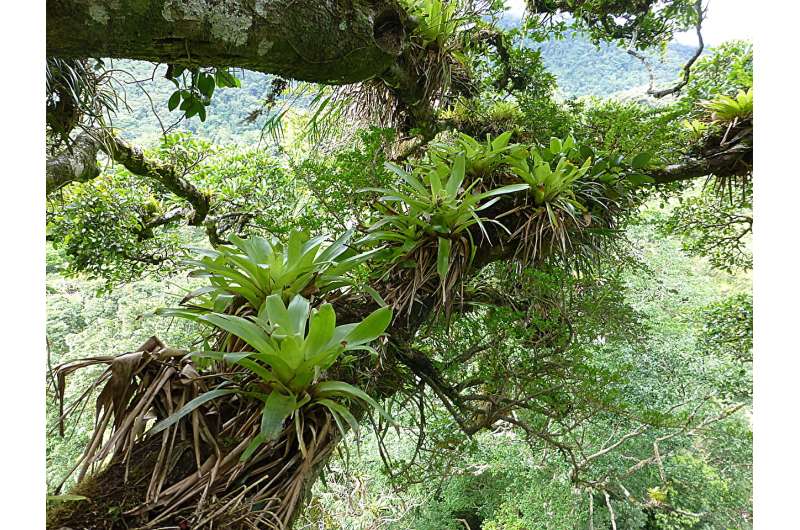This article has been reviewed according to Science X's editorial process and policies. Editors have highlighted the following attributes while ensuring the content's credibility:
fact-checked
peer-reviewed publication
trusted source
proofread
Epiphytes, amazing plants like moss and bromeliads found in trees, face growing threats

Orchids, mosses, ferns—or epiphytes, defined as nonparasitic plants that grow on other plants—are crucial for Earth's biodiversity and play essential roles in forests around the world, building habitat in trees for myriad other life forms, from bacteria and insects to birds and reptiles.
However, the very attributes that have enabled epiphytes to thrive in forest canopies are now making them vulnerable to both natural and human-caused disturbances, according to Nalini Nadkarni, the University of Utah biologist renowned for her pioneering work studying and conserving treetop ecosystems.
In a study published in New Phytologist Nadkarni found these vital plants are under more and more pressure as a result of rapid environmental change, and proposes specific actions for preserving these fascinating plants.
Nadkarni's review is titled "Complex consequences of disturbance on canopy plant communities of world forests: a review and synthesis."
"This synthesis revealed the exceptional vulnerability to the increasing levels of disturbances—such as climate change and deforestation—on the abundance diversity and connectivity of canopy-dwelling plants around the globe," she said. "Although we categorize the disturbances with greatest negative effects on canopy plants as 'natural,' as hurricanes and wildfire, human activities are increasing the severity and frequency of those in the U.S. and around the world."
Nadkarni's latest paper reviews the available science on epiphyte communities and categorizes the drivers and consequences of and societal responses to drought, wind, insects, wildfire, logging and other disturbances. Her findings should serve as a wake-up call to land managers and others interested in preserving the health of the world's woodlands.
"Across all impacts, disturbance agents were significantly more likely to lead to negative, rather than positive, effects in both tropical and temperate locales," Nadkarni wrote. The study examined 255 previous papers on ecological disturbances impacting epiphytes in 58 countries.
Nadkarni's explorations in forest canopies have inspired a generation of naturalists, drawing scientific attention to habitats that are only now becoming well understood. And epiphytes are the main attraction.
"Communities of plants that live in rainforest canopies—ferns, orchids and bromeliads—play 'keystone roles' in maintaining biodiversity, fostering critical interactions for pollination and seed dispersal and maintaining healthy nutrient cycles, even though their biomass is small relative to whole forests," she said. "Many of them have been cultivated by people for centuries because of their beauty and the ways they connect us to aesthetically and spiritually to nature."
Epiphytes display an astonishing array of diversity, with 28,000 known species. Mosses are the most prevalent kind.
"They don't have roots that go into trunks or to the forest floor, but rather it is their leaves that are adapted to intercept the dissolved nutrients that come to them in the form of mist and fog," Nadkarni said in a 2009 TED talk.
"Underneath these live epiphytes, as they die and decompose, they actually construct an arboreal soil…They have a tremendous capacity for holding onto nutrients and water," she continued.
"If you pull back on those mats of epiphytes, what you'll find underneath them are connections, networks of what we call canopy roots. These are not epiphyte roots. These are roots that emerged from the trunks and branches of the host trees themselves. And so those epiphytes are actually paying the landlord a bit of rent in exchange for being supported high above the forest floor."
Her new review found that forest fragmentation was the most frequently cited disturbance agent, followed by climate change, epiphyte harvesting, extreme events, agriculture, hurricanes and forestry activities.
"Surprisingly, relative to human disturbances (e.g., deforestation, forest fragmentation), natural disturbances (e.g., hurricanes, floods, wildfire) were more likely to lead to negative effects on epiphytes," the paper reported.
To reduce harm to epiphytes, land managers should take specific actions, such as keeping large, old trees in forestry operations, clearing only small areas to harvest epiphytes and protecting large sections of forests. They should also use epiphytes as indicators to determine how healthy an environment is and involve local communities in forest management.
In the future, Nadkarni concluded, it's crucial to share these findings with policymakers and land managers, so we can work together to protect epiphytes and the valuable roles they play in our forests.
More information: Nalini M. Nadkarni, Complex consequences of disturbance on canopy plant communities of world forests: a review and synthesis, New Phytologist (2023). DOI: 10.1111/nph.19245
Journal information: New Phytologist
Provided by University of Utah




















